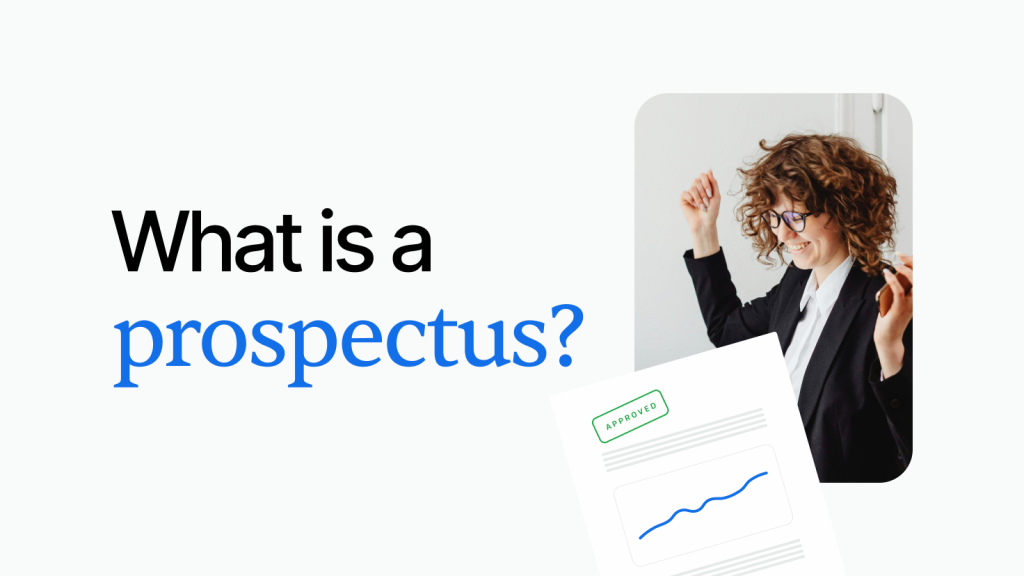Learn what a prospectus is, the differences between a prospectus and an annual report, prospectuses on Mintos, and how to effectively read a prospectus to make informed decisions. Ideal for both newbie and seasoned investors.
What is a prospectus?
A prospectus is a legal document containing the details of an investment offering to the public.
The information, format, and content disclosed in a prospectus are regulated by the European Union (EU) legal requirements for a prospectus to help investors make educated investing decisions. Every company offering financial instruments (also known as the issuer) must comply with EU prospectus rules and customize its base prospectus to fit the needs of its potential investors, depending on the type of financial instrument.
A prospectus contains the information an investor needs before deciding whether to invest in the company’s securities (such as shares and bonds).
In general, a prospectus includes information about:
- A company’s main line of business, its finances, and shareholding structure
- The securities being issued and admitted to trading
In order for every investor to receive the same level of information, EU prospectus regulations ensure that suitable and similar disclosure standards are in place in all EU member states.
On Mintos, prior to offering public securities, a base prospectus requires the approval of Latvijas Banka, the central bank of Latvia, which is the national competent authority for financial markets in Latvia. After their approval, the European Securities and Markets Authority (ESMA) registers prospectus documents.
You can find all Mintos base prospectuses on our website, on the Latvijas Banka website, and on the European Securities and Markets Authority database/register.
There are several types of prospectuses used in various financial contexts. Here are some common types:
IPO prospectus: An IPO prospectus is used when a company plans to go public and offer its shares to the public for the first time. It provides detailed information about the company, the offering, financials, risks, and other relevant details for potential investors.
Bond prospectus: A bond prospectus is used when a bond issuer (such as a corporation, government entity, or organization) plans to issue bonds to investors. It contains information about the bond offering, terms and conditions, use of proceeds, issuer’s financials, credit ratings, and risk factors.
Mutual fund prospectus: A mutual fund prospectus is provided to potential investors in a mutual fund. It includes information about the fund’s investment objectives, strategies, fees and expenses, past performance, risks, management team, and legal and tax considerations.
Real Estate Investment Trust (REIT) prospectus: A REIT prospectus is used by a real estate investment trust when offering shares to investors. It contains details about the REIT’s investment properties, financials, distribution policies, risks, management team, and other relevant information.
Each type of prospectus serves the purpose of providing comprehensive information to investors to help them make informed investment decisions.
A prospectus vs. an annual report
A prospectus and an annual report are both important financial documents, but they serve different purposes and are used in different contexts.
Key differences:
- Prospectus: A prospectus is a document that provides detailed information about a financial offering, such as an initial public offering (IPO), bond issuance, or mutual fund offering. Its primary purpose is to inform potential investors about the investment opportunity, including the terms, risks, financials, and other relevant information.
- Annual Report: An annual report is a comprehensive report that provides an overview of a company’s financial performance, operations, achievements, and outlook over the past fiscal year. Its primary purpose is to update shareholders, stakeholders, and the public about the company’s activities and financial health.
The loan securities prospectus on Mintos
All prospectuses on Mintos ensure that information shared with investors is transparent. They also define Mintos-established business structures relating to lending companies and include key subjects in these structures, setups of payment flow, risks, duties and responsibilities, terms and conditions, and liabilities.
Specific details in the loan securities prospectus relating to the lending company on Mintos are:
- Details about the loan securities’ underlying loans
- Detailed insight into the lending company of the loan securities’ underlying loans
- The financial setup and payment flow
- Lending company portfolio and statistics
- Underlying assets that ensure proceeds
- The economic environment in the relevant lending company jurisdiction
- Legal and contractual agreements between involved parties
Once approved by the competent national authority, Latvijas Banka, the base prospectus is published before investments are offered under the prospectus. The base prospectus is valid for 12 months after its approval.
The prospectus approved by Latvijas Banka cannot be modified, apart from supplementary modifications, which are amendments to the prospectus approved by Latvijas Banka. However, in case the prospectus contains a mistake or inaccuracy that is not consistent with the Prospectus Regulation, the issuer must announce to the market explaining the mistake or inaccuracy. Accordingly, such announcements are published on the Mintos website.
How to read a prospectus
Here’s a prospectus example and the key sections of a prospectus on Mintos:
The glossary
Defines subjects of the prospectus and basic terms used in the document
General description
Provides descriptions of key terms used throughout the document
Risk factors
Details potential risks related to the investment offering
General information
Details the management of the prospectus and provides guidelines for the use of the document
Transaction overview
Describes the transaction structure of the loan securities which are the subject of the particular prospectus
The issuer
Defines the issuer’s roles and responsibilities relating to the specific investment offering
Mintos
Provides details of the company and structure of other special-purpose vehicles involved in the investment flow relating to the specific investment offering
The lending company
Provides information about the lending company of the loan securities’ underlying loans
The loans
Provides detail about the loan securities’ underlying loans
Terms and Conditions of the Notes
Defines the Terms and Conditions that apply to the specific loan securities
Taxation
Provides a general summary of certain tax considerations for the specific loan securities offered in a particular market
Applicable Final Terms
Provides a template of the Final Terms document for detailed insight into a particular loan securities
Prospectuses can have additional sections. On Mintos, we have loan securities with direct structure and indirect structure. Prospectuses for loan securities with indirect structure have 2 additional sections: A special purpose vehicle (SPV), and SPV Loans. An SPV is a separate legal entity involved in the deal to isolate financial risk.
Some prospectuses also have a separate guarantors section. The guarantor is part of the loan securities–related transaction documents. The guarantor guarantees the lending company’s commitments to the Issuer if the lending company defaults.
Although a prospectus is a document with high informative value, it should not be considered investment advice. Furthermore, its approval by Latvijas Banka is not an endorsement of the loan-based investments offered on Mintos. Investing in financial instruments involves risk. There is no guarantee to get back the invested amount.

